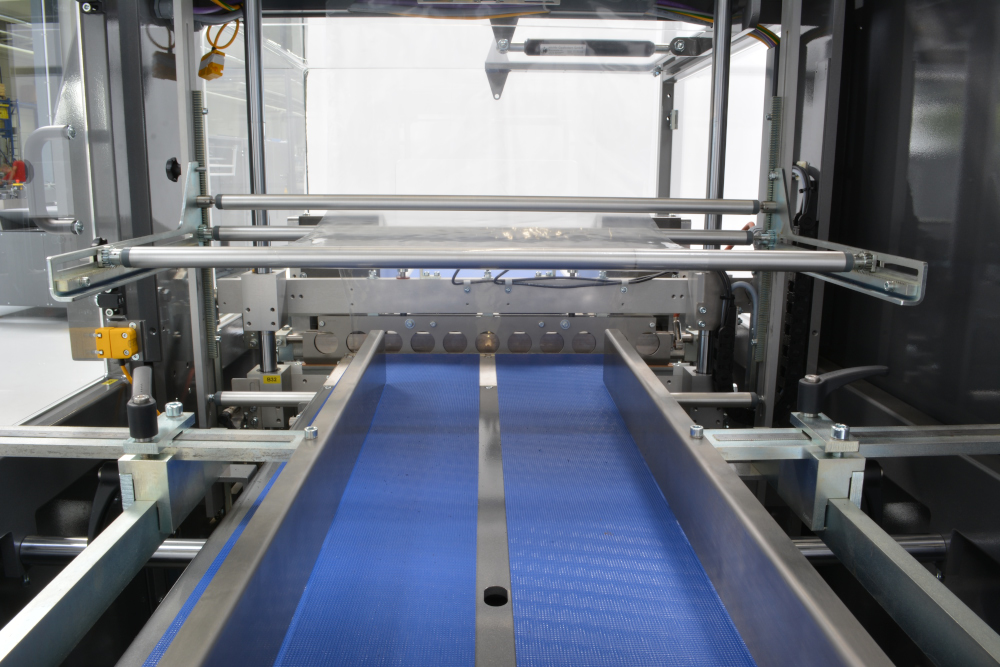
Integrating a side sealer into an automated packaging line is a strategic move for manufacturers and contract packagers seeking higher throughput, reduced labor, and consistent product presentation. Whether you’re in food, bakery, wood, cosmetics, pharmaceuticals, or printing, the right integration approach ensures your packaging operation runs smoothly and delivers maximum value.
Why Choose a Side Sealer for Automated Packaging?
A side sealer is a specialized packaging machine that wraps products in shrink film and seals the film along the side, creating a neat, tamper-evident package. Unlike traditional L-bar sealers, side sealers are designed for continuous motion, making them ideal for high-speed lines and products of varying lengths.
Benefits include:
- Consistent, professional packaging for products of different sizes.
- Reduced film waste and material costs.
- High-speed, uninterrupted operation to meet demanding production targets.
- Versatility for packaging everything from food and bakery items to electronics, books, and cosmetics.
How Do You Assess Your Packaging Line’s Needs?
Before integrating a side sealer machine, it’s crucial to evaluate your current packaging workflow. Start by identifying the types of products you need to wrap, their sizes, and the speed at which you need to operate. Consider your available floor space, existing upstream and downstream equipment, and the types of shrink films you plan to use.
Ask yourself:
- What is the range of product sizes and shapes?
- How many packages per minute must the line handle?
- Are there special hygiene or contamination concerns (e.g., for bakery or pharma)?
- What is the available footprint for new equipment?
What Preparation Is Needed for Integration?
Proper preparation ensures seamless installation and minimal disruption. Begin by mapping your packaging line, noting infeed and outfeed points, conveyor speeds, and any bottlenecks. Collaborate with your packaging equipment supplier to review technical specifications, power requirements, and film compatibility.
Key preparation steps:
- Confirm compatibility with existing conveyors and shrink tunnels.
- Plan for product accumulation zones to prevent jams.
- Ensure adequate electrical and safety provisions.
- Schedule installation during planned downtime, if possible.
How Does a Side Sealer Work Within a Packaging Line?
The side seal wrapper typically sits between the infeed conveyor and the shrink tunnel. Products enter the machine, where a cross-sealing bar and a side-sealing wheel enclose them in shrink film. Optical sensors detect product position, ensuring precise seals for each item, regardless of length or spacing.
The process:
- Products move continuously through the machine—no stop-and-go cycles.
- The side seal shrink wrap machine trims and seals the film along the side and ends.
- Wrapped products exit directly into the shrink tunnel for final film shrinking.
This continuous motion design eliminates the need for precisely matched film sizes, allowing operators to run a wide variety of products with minimal changeover.
What Are the Key Steps for Successful Integration?
- Evaluate Product Flow and Spacing
- Ensure your infeed system can handle random or irregularly spaced products.
- Adjust conveyor speeds to match the side sealer’s capacity.
- Configure the Side Sealer Machine
- Set up film guides, sealing heads, and temperature controls for your product range.
- Use user-friendly controls for quick changeovers between product sizes and films.
- Integrate Upstream and Downstream Equipment
- Synchronize the side sealer with upstream product handling (accumulators, feeders).
- Connect to downstream shrink tunnels, sorters, or case packers for a unified process.
- Test and Fine-Tune the System
- Run trial batches to check seal integrity, film shrinkage, and package appearance.
- Adjust settings for optimal speed, film usage, and product protection.
- Train Operators and Maintenance Teams
- Provide hands-on training for machine operation, troubleshooting, and routine maintenance.
- Keep documentation and support contacts accessible for quick issue resolution.
What Are the Common Challenges and Solutions?
- Film Waste and Material Costs:
Modern sealer machines with motion control technology can reduce film waste by up to 15%, delivering substantial cost savings. - Product Variability:
Side sealers excel at packaging products of varying lengths and shapes without the need for constant adjustments, making them ideal for lines with diverse SKUs. - Downtime and Maintenance:
Choose systems with minimal mechanical complexity—no compressed air, cams, or complex wiring—to reduce downtime. Look for machines with intuitive interfaces and plug-and-play integration for quick setup and maintenance. - Hygiene and Contamination:
For bakery and food applications, side sealers minimize contamination by placing seals away from areas where crumbs or toppings collect, ensuring a more secure and hygienic package.
How Do Side Sealers Enhance Packaging Efficiency?
A continuous motion packaging machine like a side sealer keeps your line running at peak efficiency. There’s no need to stop for each product, which boosts throughput and reduces labor requirements. These machines are designed for high-volume environments, with some models handling over 60 packages per minute.
Key efficiency advantages:
- Automated film feeding and cutting.
- Quick changeovers for different product sizes.
- Real-time monitoring for troubleshooting and optimization.
Also Read :
How Side Sealers Reduce Contamination in Bakery Packaging
How Do You Set Up a Side Sealer Correctly for Optimal Packaging?
How Do You Integrate a Side Sealer into an Automated Packaging Line?
Which Industries Benefit Most from Side Sealers?
Side sealer machines are used across a range of industries, including:
- Food and bakery: For tamper-evident, hygienic packaging.
- Pharmaceuticals: For secure, contamination-free wraps.
- Cosmetics and personal care: For attractive, shelf-ready packaging.
- Printing and publishing: For books, magazines, and promotional materials.
- Wood and building materials: For long or irregularly shaped items.
What Should You Look for in a Side Sealer Supplier?
Choose a supplier with a proven track record in packaging automation. At Complete Packaging Solutions & Systems Inc. / Kallfass USA, we deliver more than just machines—we provide precision-engineered solutions that redefine packaging efficiency. Our systems feature advanced motion control, seamless film versatility, and energy regeneration, ensuring you get the best in performance, uptime, and material savings.
How Can You Maximize ROI with Side Sealers?
Investing in a side seal wrapper pays off through:
- Reduced labor and material costs.
- Higher throughput and consistent product quality.
- Fewer stoppages and lower maintenance requirements.
Our machines are built for 98.5%+ uptime, easy film switching, and no programming required in the field. With local parts availability and expert support, you can trust Kallfass USA for packaging solutions that prioritize performance over price.
Transform Your Packaging Line with Expert Integration
For a seamless, high-performance integration of a side sealer or any advanced packaging automation, reach out to Complete Packaging Solutions & Systems Inc. / Kallfass USA. Let us help you achieve unmatched efficiency, reliability, and product quality with our industry-leading solutions.






